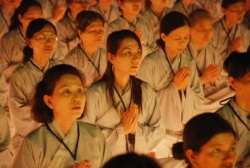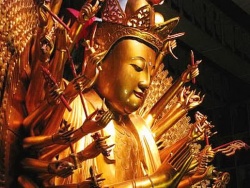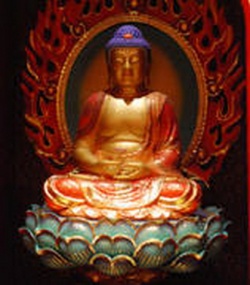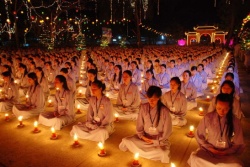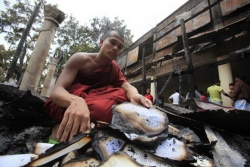Difference between revisions of "East Mountain Teaching"
(Created page with "East Mountain Teaching denotes the teachings of the Fourth Ancestor Dayi Daoxin, his student and heir the Fifth Ancestor Daman Hongren, and their students of the Chan lineage ...") |
|||
| Line 1: | Line 1: | ||
| + | [[File:Url422.jpg|thumb|250px|]] | ||
East Mountain Teaching denotes the teachings of the Fourth Ancestor Dayi Daoxin, his student and heir the Fifth Ancestor Daman Hongren, and their students of the Chan lineage of China. | East Mountain Teaching denotes the teachings of the Fourth Ancestor Dayi Daoxin, his student and heir the Fifth Ancestor Daman Hongren, and their students of the Chan lineage of China. | ||
| Line 22: | Line 23: | ||
The view of the mind in the Awakening of Faith in the Mahayana (Chinese: Ta-ch'eng ch'i-hsin lun) also had a significant import on the doctrinal development of the East Mountain Teaching.: | The view of the mind in the Awakening of Faith in the Mahayana (Chinese: Ta-ch'eng ch'i-hsin lun) also had a significant import on the doctrinal development of the East Mountain Teaching.: | ||
| − | + | [[File:Url733.jpg|thumb|250px|]] | |
: In the words of the Awakening of Faith — which summarizes the essentials of Mahayana — self and world, mind and suchness, are integrally one. Everything is a carrier of that a priori enlightenment; all incipient enlightenment is predicated on it. The mystery of existence is, then, not, "How may we overcome alienation?" The challenge is, rather, "Why do we think we are lost in the first place?" | : In the words of the Awakening of Faith — which summarizes the essentials of Mahayana — self and world, mind and suchness, are integrally one. Everything is a carrier of that a priori enlightenment; all incipient enlightenment is predicated on it. The mystery of existence is, then, not, "How may we overcome alienation?" The challenge is, rather, "Why do we think we are lost in the first place?" | ||
| Line 46: | Line 47: | ||
The successful promulgation of Shenhui's views led to Shenxiu's branch being widely referred to by others as the "Northern School." This nomenclature has continued in western scholarship, which for the most part has largely viewed Chinese Zen through the lens of southern Chan. | The successful promulgation of Shenhui's views led to Shenxiu's branch being widely referred to by others as the "Northern School." This nomenclature has continued in western scholarship, which for the most part has largely viewed Chinese Zen through the lens of southern Chan. | ||
===Northern and Southern School=== | ===Northern and Southern School=== | ||
| + | [[File:Urlbbn.jpg|thumb|250px|]] | ||
| + | |||
The terms Northern and Southern have little to do with geography: | The terms Northern and Southern have little to do with geography: | ||
| Line 69: | Line 72: | ||
===Hui-neng=== | ===Hui-neng=== | ||
| + | [[File:Urlbv.jpg|thumb|250px|]] | ||
| + | |||
The story of Huineng is famously worded in the Platform Sutra, a text which originated after Shenhui's death. Its core may have originated within the so-called Oxhead school. The text was subsequently edited and enlarged, and reflects various Chán teachings. It de-emphasizes the difference between the Northern and the Southern School. | The story of Huineng is famously worded in the Platform Sutra, a text which originated after Shenhui's death. Its core may have originated within the so-called Oxhead school. The text was subsequently edited and enlarged, and reflects various Chán teachings. It de-emphasizes the difference between the Northern and the Southern School. | ||
| Line 86: | Line 91: | ||
: In an epitaph for Shenxiu, his name is made to take the place of Faru's. The Leng-ch'ieh shih-tzu chi omits Faru and ends after Shenxiu with the name of his disciple Puji (651-739). These indications from the Northern school argue for the succession of the Third Patriarch Sengcan (d. 606), which has been thrown into doubt because of lacunae in the historical work of Tao-hsuan. Still, the matter cannot be settled with certainty. | : In an epitaph for Shenxiu, his name is made to take the place of Faru's. The Leng-ch'ieh shih-tzu chi omits Faru and ends after Shenxiu with the name of his disciple Puji (651-739). These indications from the Northern school argue for the succession of the Third Patriarch Sengcan (d. 606), which has been thrown into doubt because of lacunae in the historical work of Tao-hsuan. Still, the matter cannot be settled with certainty. | ||
| + | [[File:Urlcv.jpg|thumb|250px|]] | ||
| + | |||
Because of Faru, the 'Shaolin Monastery', constructed in 496CE, yet again became prominent. [Faru] had only a brief stay at Shaolin Temple, but during his stay the cloister became the epicentre of the flourishing Chan movement. An epitaph commemorating the success of Faru's pioneering endeavors is located on Mount Sung. | Because of Faru, the 'Shaolin Monastery', constructed in 496CE, yet again became prominent. [Faru] had only a brief stay at Shaolin Temple, but during his stay the cloister became the epicentre of the flourishing Chan movement. An epitaph commemorating the success of Faru's pioneering endeavors is located on Mount Sung. | ||
| Line 108: | Line 115: | ||
{{W}} | {{W}} | ||
| + | |||
| + | [[Category:Chinese Buddhist philosophy]] | ||
| + | [[Category:Chinese Buddhism]] | ||
| + | [[Category:Buddhist Terms]] | ||
[[Category:Chinese Buddhist philosophy]] | [[Category:Chinese Buddhist philosophy]] | ||
[[Category:Chinese Buddhism]] | [[Category:Chinese Buddhism]] | ||
[[Category:Buddhist Terms]] | [[Category:Buddhist Terms]] | ||
Revision as of 04:04, 30 December 2012
East Mountain Teaching denotes the teachings of the Fourth Ancestor Dayi Daoxin, his student and heir the Fifth Ancestor Daman Hongren, and their students of the Chan lineage of China.
East Mountain Teaching gets its name from the East Mountain Temple on 'Shuangfeng' ("Twin Peaks") of Huangmei. The East Mountain Temple was on the easternmost peak of the two. The label "East Mountain Teaching" (Chinese: 東山法門, dong shan fa men) is literally translated as the East Mountain Dharma Gate. It is also translated as the East Mountain School.
The two most famous disciples of Hongren, Dajian Huineng and Yuquan Shenxiu, both were referred as continuing the East Mountain teaching.
==History
The East Mountain School was established by Daoxin (道信 580–651)at East Mountain Temple on Potou (Broken Head) Mountain, which was later renamed Shuangfeng (Twin Peaks). Daoxin taught there for 30 years. He established the first monastic home for "Bodhidharma's Zen".
The tradition holds that Hongren (弘忍 601–674) left home at an early age (between seven and fourteen) and lived at East Mountain Temple on Twin Peaks, where Daoxiin was the abbot.
- Upon Daoxin's death [in 651 C.E]. at the age of seventy-two, Hongren assumed the abbacy. He then moved East Mountain Temple approximately ten kilometers east to the flanks of Mt. Pingmu. Soon, Hongren's fame eclipsed that of his teacher.
Teachings
The East Mountain community was a specialized meditation training centre. The establishment of a community in one location was a change from the wandering lives of Bodhiharma and Huike and their followers. It fitted better into the Chinese society, which highly valued community-oriented behaviour, instead of solitary practice
An important aspect of the East Mountain Teachings was its nonreliance on a single sutra or a single set of sutras for its doctrinal foundation as was done by most of the other Buddhist sects of the time.
The East Mountain School incorporated both the Lankavatara Sutra and the Mahaprajnaparamita Sutras.
The view of the mind in the Awakening of Faith in the Mahayana (Chinese: Ta-ch'eng ch'i-hsin lun) also had a significant import on the doctrinal development of the East Mountain Teaching.:
- In the words of the Awakening of Faith — which summarizes the essentials of Mahayana — self and world, mind and suchness, are integrally one. Everything is a carrier of that a priori enlightenment; all incipient enlightenment is predicated on it. The mystery of existence is, then, not, "How may we overcome alienation?" The challenge is, rather, "Why do we think we are lost in the first place?"
Daoxin
Daoxin is credited with several important innovations that led directly to the ability of Zen to become a popular religion. Among his most important contributions were:
- The Unification of Zen practice with acceptance of the Buddhist precepts,
- The unification of the teachings of the Lankavatara Sutra with those of the Mahaprajnaparamita Sutras, which includes the well-known Heart and Diamond sutras,
- The incorporation of chanting, including chanting the name of Buddha, into Zen practice.
Hongren
Hongren was a plain meditation teacher, who taught students of "various religious interests", including "practitioners of the Lotus Sutra, students of Madhyamaka philosophy, or specialists in the monastic regulations of Buddhist Vinaya".
Following Daoxin, Hongren included an emphasis on the Mahaprajnaparamita Sutras, including the Heart Sutra and the Diamond Sutra, along with the emphasis on the Lankavatara Sutra.
Though Hongren was known for not compiling writings and for teaching Zen principles orally, the classical Zen text Discourse on the Highest Vehicle, is attributed to him. This work emphasizes the practice of "maintaining the original true mind" that "naturally cuts off the arising of delusion."
Split in Northern and Southern School
Originally Shenxiu was considered to be the "Sixth Patriarch", carrying the mantle of Bodhidharma's Zen through the East Mountain School. After the death of Shenxiu, his student Heze Shenhui started a campaign to establish Huineng as the Sixth Ancestor. Eventually Shenhui's position won the day, and Huineng was recognized as the Sixth Patriarch.
The successful promulgation of Shenhui's views led to Shenxiu's branch being widely referred to by others as the "Northern School." This nomenclature has continued in western scholarship, which for the most part has largely viewed Chinese Zen through the lens of southern Chan.
Northern and Southern School
The terms Northern and Southern have little to do with geography:
- Contrary to first impressions, the formula has little to do with geography. Like the general designations of Mahāyāna ("great vehicle") and Hīnayāna ("little vehicle"), the formula carries with it a value judgement. According to the mainstream of later Zen, not only is sudden enlightenment incomparably superior to gradual experience but it represents true Zen - indeed, it is the very touchstone of authentic Zen.
The basic difference is between approaches. Shenhui characterised the Northern School as employing gradual teachings, while his Southern school employed sudden teachings:
- suddenness of the South, gradualness of the North" (Chinese: nan-tun bei qian; Japanese: nanton hokuzen).
The term "East Mountain Teaching" is seen as more culturally and historically appropriate.
But the characterization of Shenxiu's East Mountain Teaching as gradualist is argued to be unfounded in light of the documents found amongst manuscripts recovered from the Mogao Caves near Dunhuang. Shenhui's Southern School incorporated Northern teachings as well, and Shenhui himself admittedly saw the need of further practice after initial awakening.
Shenxiu (神秀, 606?-706 CE)
Shenxiu's prominent position in the history of Chán, despite the popular narrative, is recognized by modern scholarship:
- No doubt the most important personage within the Northern school is [Shenxiu], a man of high education and widespread notoriety.
Kuiken (undated: p. 17) in discussing a Dunhuang document of the Tang monk and meditator, 'Jingjue' (靜覺, 683- ca. 750) states:
- Jingjue's Record introduces Hongren of Huangmei 黃梅宏忍 (d.u.) as the main teacher in the sixth generation of the 'southern' or 'East Mountain' meditation tradition. Shenxiu is mentioned as Hongren's authorized successor. In Shenxiu's shadow, Jingjue mentions 'old An' 老安 (see A) as a 'seasoned' meditation teacher and some minor 'local disciples' of Hongren.
Hui-neng
The story of Huineng is famously worded in the Platform Sutra, a text which originated after Shenhui's death. Its core may have originated within the so-called Oxhead school. The text was subsequently edited and enlarged, and reflects various Chán teachings. It de-emphasizes the difference between the Northern and the Southern School.
The first chapter of the Platform Sutra relates the story of Huineng and his inheritance of the East Mountain Teachings.
Wider influence of the East Mountain Teachings
The tradition of a list of patriarchs, which granted credibily to the developing tardition, developed early in the Chán tradition:
- The consciousness of a unique line of transmission of Bodhidharma Zen, which is not yet demonstrable in the Bodhidharma treatise, grew during the seventh century and must have taken shape on the East Mountain prior to the death of the Fourth Patriarch Tao-hsin (580-651). The earliest indication appears in the epitaph for Faru (638-689), one of the '10 outstanding disciples' of the Fifth Patriarch Hongren (601-674). The author of the epitaph is not known, but the list comprises six names: after Bodhidharma and Huike follow Sengcan, Daoxin, Hongren, and Faru. The Ch'uan fa-pao chi takes this list over and adds as a seventh name that of Shen-hsiu (605?-706)
Faru (法如, 638-689 CE)
Faru (法如, 638-689) was "the first pioneer" and "actual founder" of the Northern School. His principal teachers were Hui-ming and Daman Hongren (Hung-jen). He was sent to Hongren by Hui-ming, and attained awakening when studying with Hung-jen
Originally Faru too was credited to be the successor of Hongren. But Faru did not have a good publicist, and he was not included within the list of Chan Patriarchs.
- In an epitaph for Shenxiu, his name is made to take the place of Faru's. The Leng-ch'ieh shih-tzu chi omits Faru and ends after Shenxiu with the name of his disciple Puji (651-739). These indications from the Northern school argue for the succession of the Third Patriarch Sengcan (d. 606), which has been thrown into doubt because of lacunae in the historical work of Tao-hsuan. Still, the matter cannot be settled with certainty.
Because of Faru, the 'Shaolin Monastery', constructed in 496CE, yet again became prominent. [Faru] had only a brief stay at Shaolin Temple, but during his stay the cloister became the epicentre of the flourishing Chan movement. An epitaph commemorating the success of Faru's pioneering endeavors is located on Mount Sung.
Pao-t'ang (無住; Wu-chu; 714-774 CE)
Pao-t'ang Wu-chu or 'Bao-tang Wu-zhu' (保唐无住) (Chinese: 無住; Wu-chu; 714-774CE), head and founder of Pao-t'ang Monastery (Chinese: 保唐寺) at Chengdu, Szechwan located in south west China was a member of the East Mountain Teachings as was Reverend Kim (Chin ho-shang).
Moheyan (late eighth century CE)
Moheyan (late eighth century CE) was a proponent of the Northern School. Moheyan traveled to Dunhuang, which at the time belonged to the Tibetan Empire, in 781 or 787 CE.
Moheyan participated in a prolonged debate with Kamalashila at Samye in Tibet over sudden versus gradual teachings, which was decisive for the course the Tibetan Buddhist tradition took:
- As is well known, the fate of Chan [East Mountain Teachings] in Tibet was said to have been decided in a debate at the Samye monastery near Lhasa in c.792-797.
Broughton identifies the Chinese and Tibetan nomenclature of Mohoyen's teachings and identifies them principally with the East Mountain Teachings:
- Mo-ho-yen's teaching in Tibet as the famed proponent of the all-at-once gate can be summarized as "gazing-at-mind" (Chinese: k'an-hsin, Tibetan: sems la bltas) and "no examining" (Chinese: pu-kuan, Tibetan: myi rtog pa) or "no-thought no-examining" (Chinese: pu-ssu pu-kuan, Tibetan: myi bsam myi rtog). "Gazing-at-mind" is an original Northern (or East Mountain Dharma Gate) teaching. As will become clear, Poa-t'ang and the Northern Ch'an dovetail in the Tibetan sources. Mo-ho-yen's teaching seems typical of late Northern Ch'an. It should be noted that Mo-ho-yen arrived on the central Tibetan scene somewhat late in comparison to the Ch'an transmissions from Szechwan.
The teachings of Moheyan and other Chan masters were unified with the Kham Dzogchen lineages {this may or may not be congruent with the Kahma (Tibetan: bka' ma) lineages} through the Kunkhyen (Tibetan for "omniscient"), Rongzom Chokyi Zangpo.
The Dzogchen ("Great Perfection") School of the Nyingmapa was often identified with the 'sudden enlightenment' (Tibetan: cig car gyi ‘jug pa) of Moheyan and was called to defend itself against this charge by avowed members of the Sarma lineages that held to the staunch view of 'gradual enlightenmnent' (Tibetan: rim gyis ‘jug pa).
